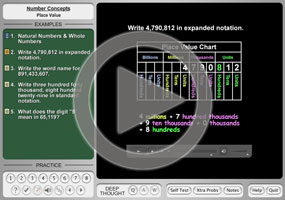Place Value: Concepts
Purplemath
What is place value?
Place value is the practice of assigning a value to a numeral according to its placement within the entire written number.
What is an example of place value?
The place value of the numeral 2 within the number 12 is two ones, because the numeral 2 is in the ones "place"; the place value of the numeral 2 in 21 is two tens, because the numeral 2 is in the tens "place".
Content Continues Below
What is a place-value number?
A place-value number is one in which the individual characters' values are determines by position, rather than by, in a sense, their shape. In Roman numerals, the character M always stands for "one thousand". The expression MMM stands for "three thousand" because the character for one thousand is repeated three times.
In our place-value system, the character 1 can stand for loads of different values, depending upon its place within that number. The expression 111 stands for "one hundred eleven" (where "eleven" is English for "one ten and one one"). Each of the 1s stood for a different value, according to the place of the 1.
At least, this is what the textbooks tell us. But what does it all mean?
An intuitive explanation of "place value"?
To explain the concept of "place value", I'll start with some comparisons. First, let's look at the word "records" in these two sentences:
Security camera 4 records all activity in the rear of the building.
The building's security office saves the records of every shoplifter they've caught in the previous five years.
In the first sentence, "records" is pronounced as "reh-KORDZ" and is a verb; in the second sentence, "records" is pronounced as "REH-kerdz" and is a noun. The "value" of the word changed, depending on the word's "place" in the sentence structure.
Now, let's imagine looking at the security footage being stored in the security office; in particular, we'll look at the 24-hour timestamps 00:00:15, 00:15:00, and 15:00:00. (A 24-hour clock means, for instance, that "1 PM" is "13 hours".)
- The first timestamp, 00:00:15, means "zero hours, zero minutes, and fifteen seconds"; in other words, fifteen seconds after midnight.
- The second timestamp, 00:15:00, means "zero hours, fifteen minutes, and zero seconds"; in other words, exactly fifteen minutes past midnight.
- The third timestamp, 15:00:00, means "fifteen hours, zero minutes, and zero seconds"; in other words, exactly three o'clock in the afternoon.
Advertisement
In each of these timestamps, the "15" told the time. But the "15" meant a different thing in each case — 15 seconds, 15 minutes, or 15 hours, depending on the context. The "place" where the "15" was — in the "hours" slot, the "minutes" slot, or the "seconds" slot — told us what the "value" of the "15" was for that particular timestamp.
Affiliate
What is the importance of zero in place value?
Zero is fundamental to place value; zeroes hold numerals in their correct places, making the meaning clear. In our security-camera example, without the zeroes, the timestamp "00:00:15" would have collapsed into just "15", as would have the other two timestamps. Those zeroes held all the slots (hours, minutes, and seconds) in their proper places, preserving the meanings of the timestamps. Since the value of "15" varies with the place, it is vitally important that those other places not disappear. The zeroes are crucial to the meaning.
Now let's think about counting. When we were little kids, we started counting on our fingers. If we were counting up ("tallying") a larger number of things, we might write down tally marks to keep track:

But once we got into bigger numbers, the thicket of tally marks started being unhelpful.

We could count up to ten on our fingers, but what then? We were out of fingers.
Content Continues Below
But let's say we also had some marbles. Every time we used up all of our fingers in counting up to ten, we could go back to fists (that is, to zero fingers) and we could put a marble down, standing for "one time of all-my-fingers" (that is, one time of ten).

So three marbles and two fingers would be "three times of ten, plus another two fingers", or "thirty-two", as shown below:

When we get ten marbles in the pile, we can't count any more of "all-my-fingers" because we're out of fingers to use for counting the marbles. So let's start a second pile, further away, to stand for "ten 'all-my-fingers' marbles". We'll call these new "ten 'all-my-fingers' marbles" (that is, the new marbles which stand for ten times of ten fingers) "one hundred" marbles. Then this:

...means "two times of ten-times-of-ten, plus six times of all-my-fingers, plus another four fingers", or "two hundred sixty-four".
Affiliate
Of course, if somebody trips over our piles of marbles, we'll lose count. Once the marbles are no longer in their proper places, we can't tell what values they were meant to represent. It's be just like with the security-tape's timestamps, where we wouldn't have known what each "15" had stood for if somebody had stripped out all the zeroes.
This concept that "the value of the marble (or the 15) depends on the pile (or slot) in which the marble (or 15) has been placed" is the point of "place values" in writing number names; namely, the place where the digit has been put tells you the actual value of that digit.
URL: https://www.purplemath.com/modules/placeval.htm
Select a Course Below
Standardized Test Prep
Homeschool Math
© 2024 Purplemath, Inc. All right reserved. Web Design by ![]()




